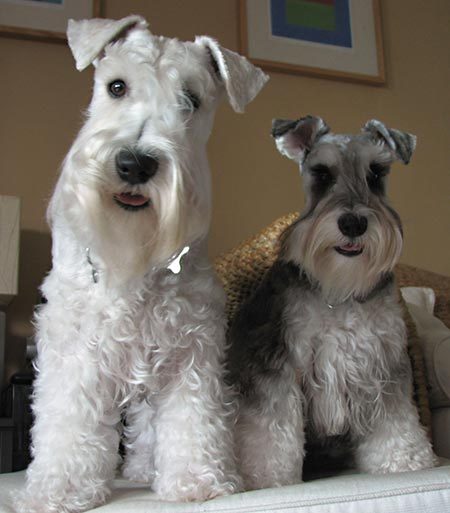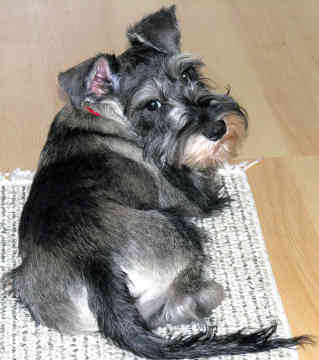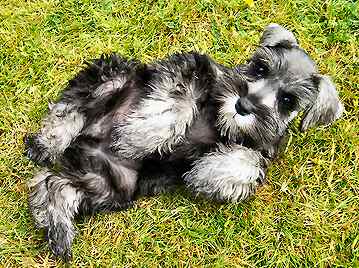

Miniature Schnauzers
The
Miniature Schnauzer is
a
breed
of small
dog
of the
Schnauzer
type that originated in
Germany
in the mid-to-late 19th century. Miniature Schnauzers developed from crosses
between the
Standard
Schnauzer
and one or more smaller breeds such as the
Poodle
or
Affenpinscher.[1]
The breed remains one of the most popular, and as of 2008 is the 11th most popular breed in the U.S, primarily for its temperament and relatively small size. The American Kennel Club recognizes only three colors for the Miniature Schnauzer: salt-and-pepper, black-and-silver, and solid black. Solid white is considered a disqualification, although, a small patch of white is allowed on the solid black[3]. In the United Kingdom, the small white patch on a solid black is also considered a fault [4]. Colors such as white, parti (multi), chocolate and liver are available on the pet trade and can be registered as pure-breds by some organizations, but are not currently recognized by any legitimate clubs for conformation shows.

Miniature Schnauzers normally
have a small, squarely proportioned build, measuring 12 to 14 inches (30 to
36 cm) tall and weighing 11 to 15 pounds (5.0 to 6.8 kg) for females and 14 to
18 pounds (6.4 to 8.2 kg) for males. They have a double coat. The exterior fur
is wiry and the undercoat is softer. The coat is trimmed short on the body, but
the hair on ears, legs, and edge of the body, a.k.a. the "furnishings", are
retained. The first Breed Standard for the Schnauzer, established in 1907,
required specific color formation: "Color: All salt and pepper color shades or
similar bristly equal color mixtures and solid black. Faults: ...All white,
speckled, brindles, red, or bran colors."
Miniature Schnauzers are often described as non-shedding dogs, and while this is not entirely true, their shedding is minimal and generally unnoticeable. They are characterized by a long head with bushy beard, mustache and eyebrows; teeth that meet in a "scissor bite"; oval and dark colored eyes; and v-shaped, natural forward-folding ears. (When cropped, the ears point straight upward and come to a sharp point.) Their tails are naturally thin and short, and may be docked (where permitted). They will also have very straight, rigid front legs, and feet that are short and round (so-called "cat feet") with thick, black pads.
Temperament
The Official Standard of the
Miniature Schnauzer describes temperament as "alert and spirited, yet obedient
to command. He is friendly, intelligent and willing to please. He should never
be overaggressive or timid." Usually easy to train, they tend to be excellent
watchdogs, with a good territorial instinct, but more inclined toward vocal
notification than attack. They are often guarded towards strangers until the
owners of the home welcome the guest, upon which they are typically very
friendly to them; unlike some of their terrier cousins, they are not typically
aggressive. However, they will express themselves vocally, and may bark to greet
their owner, or to express joy, excitement, or displeasure.
Proper socialization with other dogs and people is important. The breed is generally good with children, but as with any dog, play with small children should be supervised. They are highly playful dogs, and if not given the outlet required for their energy they can become bored and invent their own "fun." Schnauzers have a "high prey drive" (appropriate for a ratting dog), which means they may attack other small pets such as birds, snakes, and rodents. Many will also attack cats, but this may be curbed with training, or if the dog is raised with cats.
History
The
earliest records surrounding development of the Miniature Schnauzer in Germany
come from the late 1800s. They were originally bred to be farm dogs in Germany,
to keep the rats and other vermin out of the barn. With their bold courage, the
Miniature Schnauzer was originally used for guarding herds, small farms, and
families.[citation
needed]
As time passed, they were also used to hunt rats, because they appeared to have
a knack for it, and their small size was perfect to get into tight places to
catch them.[citation
needed]
In the
breed's earliest stages, several small breeds were employed in crosses to bring
down the size of the well-established Standard Schnauzer, with the goal of
creating a duplicate in miniature. Crossing to other breeds, such as the
Affenpinscher,
Poodle
and
Miniature
Pinscher,
had the side effect of introducing colors that were not considered acceptable to
the ultimate goal — and as breeders worked towards the stabilization of the gene
pool, miss-marked particolors (mixed colors) and white puppies were removed from
breeding programs. Since the 1950s, white puppies have re-emerged as a potential
color variant, giving rise to the White Schnauzer Controversy (see below).
The first recorded Miniature Schnauzer appeared in 1888, and the first exhibition was held in 1899. The AKC accepted registration of the new breed in 1926, two years after Miniature Schnauzers were introduced to the United States.[6] The AKC groups this breed with the Terriers, because it was developed for a similar purpose and has a similar character to the terrier breeds of the Britain and Ireland.

The
Miniature Schnauzer was recognized by the
United Kennel
Club
in 1948 and also groups the breed as a terrier. The United Kingdom
The Kennel
Club
however, does not accept the Miniature Schnauzer as a true Terrier because it
does not originate from the terrier breeds of the British Isles. Like the
Tibetan Terrier and Boston Terrier, it lists the Miniature Schnauzer in the
Utility group for shows run under the UK Kennel Club rules such as
Crufts.
The
World Canine
Organization
accepts the Schnauzer breeds but, again, does not list the Miniature Schnauzer
as a Terrier, although it accepts the White Schnauzer for conformation.
The mini is also recognized by the CKC ( Continental Kennel Club).
Health and grooming
While generally a healthy breed, Miniature Schnauzers may suffer health problems
associated with high fat levels. Such problems include
hyperlipidemia,
which may increase the possibility of
pancreatitis,
though either may form independently. Other issues which may affect this breed
are
diabetes,
bladder stones
and eye problems. Feeding the dog low- or non-fatty and unsweetened foods may
help avoid these problems. Miniature Schnauzers are also prone to
come done syndrome, a condition that produces pus
filled bumps, usually on their backs, which can be treated with a variety of
protocols. Miniature Schnauzers should have their ears dried after swimming due
to a risk of infection, especially those with uncropped ears; ear examinations
should be part of the regular annual check up.
Salt-and-pepper Miniature Schnauzer. This Mini's white furnishings contrast with his dark (pepper) coat. The grooming of this dog shows the precision necessary for a show quality coat.

Schnauzers require regular grooming, either by stripping (the approved method), or by clipping (a short-cut usually reserved for family pets). Stripping removes the loose, dead coat; it may be done by hand, called finger stripping, or plucking, or with a stripping knife; either way, it is a laborious process. Many Miniature Schnauzers who are family pets have regular grooming appointments to have their hair clipped; clipping, using a mechanical clippers (or shaver), produces a soft, silky, skin-close trim. Whether stripped or clipped, the coat is close at the body, and falls into a fringe-like foundation on their undercarriage, called furnishings, which can be left to grow, but must be combed regularly. All Schnauzers, whether they are minis, Standards, or Giants, often sport a beard, created by allowing the hair around their noses to grow out. Left unclipped or unstripped, the body hair will grow two to four inches, and will often tangle into mats and curls.
White Schnauzer Controversy
The
White Schnauzer is one
of four color varieties of the Miniature Schnauzer recognized by the
Pinscher-Schnauzer Klub of Germany and the
World Canine
Organization.
Not all dog fanciers accept the white variety as a legitimate variation for
conformation (show) standards and they are not accepted by either the American
Kennel Club or the Canadian Kennel Club. The controversy rests on the disputed
origins of the white variation, if it is a naturally occurring, albeit
recessive, color, an albino characteristic, or an unhealthy genetic mutation.
From pedigree research, the "white" (gelb or "yellow" as it was called in early German records) gene was introduced into the Miniature Schnauzer breed mainly through a German black Champion Miniature Schnauzer named Peter V Westerberg (PZ604), born in November 1902. Peter was obviously carrying one "e" gene because it is recorded that he was bred to a female named Gretel VD Werneburg (PZ1530) (color unknown) and produced a "yellow" female pup named Mucki VD Werneburg (PSZ 8) born October 1914.
Mucki was bred to a grandson of Peter named Pucki VD Werneburg, a dark Salt and Pepper variation PSZ12, who in turn produced the black German Champion Peterle VD Werneburg, PSZ11 born June 2, 1916, who also had to have the "e" gene, since his dam was yellow. Peter V Westerburg or his grandson, Peterle (literally, little Peter), can be traced to nearly every Miniature Schnauzer line researched in AKC records. For example, tracing every ancestor in the 5th generation of Dorem Display[clarification needed] reveals every dog goes back to Peter Von Westerberg. Any time one established breed is crossed with another, or when breeds are bred over generations for specific features, for whatever reason, part of that breed's characteristics are inherited through the DNA structure, whether it be color, structure, working ability, temperament, disease, or any other heritable trait.
The
only way to prove whether a dog carries a certain inherited breed trait is by
DNA testing,
and DNA testing was not available when white first appeared as a coat color in
miniature Schnauzers. Miniature Schnauzer breeders claimed they had eradicated
the white gene in the early twentieth century. With so many line-bred crosses,
it is statistically impossible to eradicate the "white" "e" gene by visual
assessment alone.
Compounding the controversy, there are no known factual data to back up the assertion that gelb is equal to 'white'. The originators of the breed in the late 1800s and early 1900s in Germany wanted an exact duplicate of the Standard Schnauzer. The Standard Schnauzer has never appeared in the white or even the gelb color variety. The original Schnauzer Club in Germany disqualified whites and told breeders of Parti colors and solid whites to not continue to produce those colors, as they went against the ideal breed standard.
After testing several unrelated white dogs from around the world, it has been recently proven by DNA testing that the genotype for the White Miniature Schnauzer is "e/e" at MC1r (commonly referred to as the "E" locus). The "E", a normal extension of black, allows the A-series alleles to show through, and "e", recessive red/yellow, overrides whatever gene is present at the A locus to produce a dog which shows only phaeomelanin pigment in the coat. Skin and eye color show apparently normal eumelanin, although some "e,e" dogs appear to show reduced pigment on the nose, especially in winter (snow nose), but after sunbathing in warm weather, they regain the black pigment on their noses, much like humans getting a tan in summer. Most white Miniature Schnauzers with original harsh coats will have a yellowish streak on their backs and head when their hair is hand stripped and the ends become blown or dead. It is assumed this is why they were originally called "yellow" in German records.
There are two forms of melanin (pigment) in mammals' hair coats. The first is called eumelanin. The base form of eumelanin is black. Eumelanin can also appear brown (often called liver in dogs) or blue-gray. The second pigment, which varies from pale cream through shades of yellow, tan, and orange/red is called phaeomelanin.
All dogs have alleles at every
locus. Not all proposed alleles have been proven to exist. The generally
recognized color loci in dogs are referred to as: A (agouti), B (brown), C
(albino series), D (blue dilution) E (extension), G (graying), M (merle), R (roaning),
S (white spotting) and T (ticking.) There may be more, still unrecognized gene
series, and in a given breed, modifying factors may drastically affect the
actual appearance. The newest proposed locus is the K locus for dominant black
in certain breeds, including the Miniature Schnauzer.
White Miniature Schnauzers do
not possess the "d" allele, which is commonly known as the Dilution gene
responsible for diluting both eumelanin and phaeomelanin pigment. This stands to
reason because true white Miniature Schnauzers have black skin pigment and dark
eyes.
Genotypes for the white Miniature Schnauzer are proposed as follows, showing they can "carry" for any of the other 3 colors of solid Black,B&S or S&P:
Controversy today
Today, the American Miniature Schnauzer Club and the American Kennel Club standard describes the White Miniature Schnauzers as a disqualification from conformation shows. The American Miniature Schnauzer Club and AKC maintain the colors from original breed standards. Breeders of the white variant claim that these dogs have no known congenital or lethal white gene theories. They are not albino dogs, and white dogs described as Miniature Schnauzers are affectionate and robust dogs who exhibit all the qualities of their colored counterparts.
The Federation Cynologique Internationale (FCI) now acknowledges white in the breed standards set forth by the countries of breed origins. The White Miniature Schnauzer may compete in other AKC sanctioned events such as agility, Canine Good Citizen, Obedience, or Earthdog trials, but not in conformation competition. The White Miniature Schnauzer may be shown in Conformations shows sanctioned by the FCI in international competitions, and the white variant is becoming very popular in Europe as a show dog.
The White Miniature Schnauzer Initiative was established in 2006 in Germany for friends and breeders of the White Miniature Schnauzers worldwide to promote interest and provide an informative network for sharing ideas and information and to give breeders the opportunity to exchange and expand the gene pool of the white Miniature Schnauzers worldwide.
Click here to go to the top of the page
